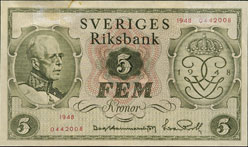 The crises in the 1930s and the Second World War led to strong regulation of the international economy. Sweden’s domestic policy focused on full employment and housing.
The crises in the 1930s and the Second World War led to strong regulation of the international economy. Sweden’s domestic policy focused on full employment and housing.
The Riksbank’s low interest rate policy forced interventions in the market, but when the Bretton Woods system collapsed in the early 1970s the regulated economy becomes harder to manage. The fall of the Bretton Woods system meant that the world’s currency regimes were no longer pegged to any valuable metal and the value of a currency was instead entirely dependent on how much confidence other countries had in it. The closing years of the era were marked by the oil crisis, wage inflation and a growing budget deficit.
Time axis
| 1944 |
The labour movement’s post-war
programme. Low interest rates, high
taxation.
|
| 1946 |
The krona is revalued, by 17 per cent
against the dollar.
|
| 1948 |
Governor Rooth resigns in protest
at the low-interest-rate policy and is
succeeded by Klas Böök.
The Marshall Plan.
|
| 1949 |
The krona is devalued, by 30.5 per
cent against the dollar.
|
| 1951 |
Sweden joins the Bretton Woods
system. Mats Lemne is appointed
governor of the Riksbank.
|
| 1952 |
Liquidity ratios are introduced.
|
| 1955 |
Per Åsbrink is appointed governor
of the Riksbank.
|
| 1957 |
Åsbrink’s interest rate coup.
|
| 1958 |
The krona becomes convertible.
|
| 1964 |
The Riksdag institutes the Bank of
Sweden Tercentenary Foundation.
|
| 1968 |
The Riksbank’s tercentenary.
The Alfred Nobel Memorial Prize
in Economic Sciences is founded.
|
| 1970 |
The ‘idiotic squeeze’.
|
| 1973 |
Krister Wickman is appointed
governor of the Riksbank.
|
| 1973-1976 |
Bridging the international
recession.
|
| 1976 |
Carl-Henrik Nordlander is appointed
governor of the Riksbank.
|
| 1976-1977 |
Three devaluations of the krona.
|
| 1979 |
Lars Wohlin is appointed governor
of the Riksbank.
|
| 1981 |
The krona is devalued. |
Did you find this information helpful?
Yes
No
Thank you for your help!